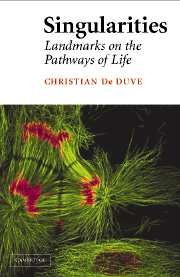Book contents
- Frontmatter
- Contents
- Foreword
- On Christian de Duve: An Editor's Appreciation
- General Introduction
- 1 Building Blocks
- 2 Homochirality
- 3 Protometabolism
- 4 ATP
- 5 Electrons and Protons
- 6 Thioesters
- 7 RNA
- 8 Proteins
- 9 DNA
- 10 Membranes
- 11 Protonmotive Force
- 12 Protometabolism Revisited
- 13 The LUCA
- 14 The First Fork
- 15 Eukaryotes
- 16 Oxygen
- 17 Endosymbionts
- 18 Multicellulars
- 19 Homo
- 20 Evolution
- Final Comments
- Bibliography
- Index
13 - The LUCA
Published online by Cambridge University Press: 18 January 2010
- Frontmatter
- Contents
- Foreword
- On Christian de Duve: An Editor's Appreciation
- General Introduction
- 1 Building Blocks
- 2 Homochirality
- 3 Protometabolism
- 4 ATP
- 5 Electrons and Protons
- 6 Thioesters
- 7 RNA
- 8 Proteins
- 9 DNA
- 10 Membranes
- 11 Protonmotive Force
- 12 Protometabolism Revisited
- 13 The LUCA
- 14 The First Fork
- 15 Eukaryotes
- 16 Oxygen
- 17 Endosymbionts
- 18 Multicellulars
- 19 Homo
- 20 Evolution
- Final Comments
- Bibliography
- Index
Summary
There is overwhelming proof that all known living organisms descend from a single ancestral form, the LUCA, or last universal common ancestor, also called cenancestor by some. Conclusively evidenced by the many singularities already discussed, the single origin of all known forms of life is further demonstrated by the many sequence similarities that exist among genes that perform the same functions in very different organisms, be they microbes, plants, fungi, or animals, including humans. It is clear that such similarities can be explained only on the basis of direct kinship among the genes concerned, leading to the obvious conclusion that the owners of the genes must be similarly related.
This seemingly unassailable conclusion has come under challenge in recent years, on the ground that genes do not only travel vertically, from one generation to another, but may also be exchanged horizontally between two totally unrelated cells. This point is relevant to the construction of molecular phylogenies (see next chapter) but does not seriously undermine the theory of single origin, which rests on a solid body of convergent evidence and allows a number of straightforward considerations, irrespective of phylogenetic details. These considerations will be the topic of the present chapter, leaving phylogenies to be discussed in the next one.
A Reconstructed Portrait of the LUCA
According to simple logic, it should be easy to arrive at a minimal representation of the LUCA by putting together all the properties shared by all present-day organisms, the rationale being that these properties must all have been inherited from the LUCA.
- Type
- Chapter
- Information
- SingularitiesLandmarks on the Pathways of Life, pp. 161 - 169Publisher: Cambridge University PressPrint publication year: 2005

